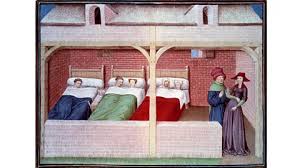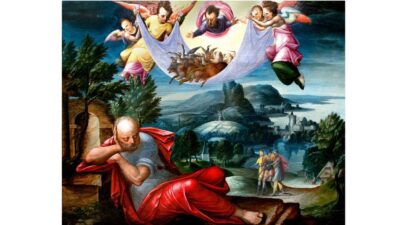
It was around 23:00 on 13 April 1699, in a small village in the north of England. Nine-year-old Jane Rowth blinked her eyes open and squinted out into the moody evening shadows. She and her mother had just awoken from a short sleep.
Mrs Rowth got up and went over to the fireside of their modest home, where she began smoking a pipe. Just then, two men appeared by the window. They called out and instructed her to get ready to go with them.
As Jane later explained to a courtroom, her mother had evidently been expecting the visitors. She went with them freely – but first whispered to her daughter to “lye still, and shee would come againe in the morning”. Perhaps Mrs Rowth had some nocturnal task to complete. Or maybe she was in trouble, and knew that leaving the house was a risk.
Either way, Jane’s mother didn’t get to keep her promise – she never returned home. That night, Mrs Rowth was brutally murdered, and her body was discovered in the following days. The crime was never solved.
Nearly 300 years later, in the early 1990s, the historian Roger Ekirch walked through the arched entranceway to the Public Record Office in London – an imposing gothic building that housed the UK’s National Archives from 1838 until 2003. There, among the endless rows of ancient vellum papers and manuscripts, he found Jane’s testimony. And something about it struck him as odd.
Originally, Ekirch had been researching a book about the history of night-time, and at the time he had been looking through records that spanned the era between the early Middle Ages and the Industrial Revolution. He was dreading writing the chapter on sleep, thinking that it was not only a universal necessity – but a biological constant. He was sceptical that he’d find anything new.
So far, he had found court depositions particularly illuminating. “They’re a wonderful source for social historians,” says Ekirch, a professor at Virginia Tech, US. “They comment upon activity that’s oftentimes unrelated to the crime itself.”
But as he read through Jane’s criminal deposition, two words seemed to carry an echo of a particularly tantalising detail of life in the 17th Century, which he had never encountered before – “first sleep”.
“I can cite the original document almost verbatim,” says Ekirch, whose exhilaration at his discovery is palpable even decades later.
In her testimony, Jane describes how just before the men arrived at their home, she and her mother had arisen from their first sleep of the evening. There was no further explanation – the interrupted sleep was just stated matter-of-factly, as if it were entirely unremarkable. “She referred to it as though it was utterly normal,” says Ekirch.
A first sleep implies a second sleep – a night divided into two halves. Was this just a familial quirk, or something more?
An omnipresence
Over the coming months, Ekirch scoured the archives and found many more references to this mysterious phenomenon of double sleeping, or “biphasic sleep” as he later called it.
Some were fairly banal, such as the mention by the weaver Jon Cokburne, who simply dropped it into his testimony incidentally. But others were darker, such as that of Luke Atkinson of the East Riding of Yorkshire. He managed to squeeze in an early morning murder between his sleeps one night – and according to his wife, often used the time to frequent other people’s houses for sinister deeds.

When Ekirch expanded his search to include online databases of other written records, it soon became clear the phenomenon was more widespread and normalised than he had ever imagined.
For a start, first sleeps are mentioned in one of the most famous works of medieval literature, Geoffrey Chaucer’s The Canterbury Tales (written between 1387 and 1400), which is presented as a storytelling contest between a group of pilgrims. They’re also included in the poet William Baldwin’s Beware the Cat (1561) – a satirical book considered by some to be the first ever novel, which centres around a man who learns to understand the language of a group of terrifying supernatural cats, one of whom, Mouse-slayer, is on trial for promiscuity.
But that’s just the beginning. Ekirch found casual references to the system of twice-sleeping in every conceivable form, with hundreds in letters, diaries, medical textbooks, philosophical writings, newspaper articles and plays.
The practice even made it into ballads, such as “Old Robin of Portingale. “… And at the wakening of your first sleepe, You shall have a hot drink made, And at the wakening of your next sleepe, Your sorrows will have a slake…”
Biphasic sleep was not unique to England, either – it was widely practised throughout the preindustrial world. In France, the initial sleep was the ” premier somme“; in Italy, it was ” primo sonno“. In fact, Eckirch found evidence of the habit in locations as distant as Africa, South and Southeast Asia, Australia, South America and the Middle East.
One colonial account from Rio de Janeiro, Brazil in 1555 described how the Tupinambá people would eat dinner after their first sleep, while another – from 19th Century Muscat, Oman – explained that the local people would retire for their first sleep before 22:00.
And far from being a peculiarity of the Middle Ages, Ekirch began to suspect that the method had been the dominant way of sleeping for millennia – an ancient default that we inherited from our prehistoric ancestors. The first record Ekirch found was from the 8th Century BC, in the 12,109-line Greek epic The Odyssey, while the last hints of its existence dated to the early 20th Century, before it somehow slipped into oblivion.
How did it work? Why did people do it? And how could something that was once so completely normal, have been forgotten so completely?
A spare moment
In the 17th Century, a night of sleep went something like this.

From as early as 21:00 to 23:00, those fortunate enough to afford them would begin flopping onto mattresses stuffed with straw or rags – alternatively it might have contained feathers, if they were wealthy – ready to sleep for a couple of hours. (At the bottom of the social ladder, people would have to make do with nestling down on a scattering of heather or, worse, a bare earth floor – possibly even without a blanket.)
At the time, most people slept communally, and often found themselves snuggled up with a cosy assortment of bedbugs, fleas, lice, family members, friends, servants and – if they were travelling – total strangers.
To minimise any awkwardness, sleep involved a number of strict social conventions, such as avoiding physical contact or too much fidgeting, and there were designated sleeping positions. For example, female children would typically lie at one side of the bed, with the oldest nearest the wall, followed by the mother and father, then male children – again arranged by age – then non-family members.
A couple of hours later, people would begin rousing from this initial slumber. The night-time wakefulness usually lasted from around 23:00 to about 01:00, depending on what time they went to bed. It was not generally caused by noise or other disturbances in the night – and neither was it initiated by any kind of alarm (these were only invented in 1787, by an American man who – somewhat ironically – needed to wake up on time to sell clocks). Instead, the waking happened entirely naturally, just as it does in the morning.
The period of wakefulness that followed was known as “the watch” – and it was a surprisingly useful window in which to get things done. “[The records] describe how people did just about anything and everything after they awakened from their first sleep,” says Ekirch.
Under the weak glow of the Moon, stars, and oil lamps or “rush lights” – a kind of candle for ordinary households, made from the waxed stems of rushes – people would tend to ordinary tasks, such as adding wood to the fire, taking remedies, or going to urinate (often into the fire itself).
For peasants, waking up meant getting back down to more serious work – whether this involved venturing out to check on farm animals or carrying out household chores, such as patching cloth, combing wool or peeling the rushes to be burned. One servant Ekirch came across even brewed a batch of beer for her Westmorland employer one night, between midnight and 02:00. Naturally, criminals took the opportunity to skulk around and make trouble – like the murderer in Yorkshire.
But the watch was also a time for religion.
For Christians, there were elaborate prayers to be completed, with specific ones prescribed for this exact parcel of time. One father called it the most “profitable” hour, when – after digesting your dinner and casting off the labours of the world – “no one will look for you except for God”.
Those of a philosophical disposition, meanwhile, might use the watch as a peaceful moment to ruminate on life and ponder new ideas. In the late 18th Century, a London tradesman even invented a special device for remembering all your most searing nightly insights – a “nocturnal remembrancer”, which consisted of an enclosed pad of parchment with a horizontal opening that could be used as a writing guide.
But most of all, the watch was useful for socialising – and for sex.
As Ekirch explains in his book, At Day’s Close: A History of Nighttime, people would often just stay in bed and chat. And during those strange twilight hours, bedfellows could share a level of informality and casual conversation that was hard to achieve during the day.
For husbands and wives who managed to navigate the logistics of sharing a bed with others, it was also a convenient interval for physical intimacy – if they’d had a long day of manual labour, the first sleep took the edge off their exhaustion and the period afterwards was thought to be an excellent time to conceive copious numbers of children.
Once people had been awake for a couple of hours, they’d usually head back to bed. This next step was considered a “morning” sleep and might last until dawn, or later. Just as today, when people finally woke up for good depended on what time they went to bed.
An ancient adaptation
According to Ekirch, there are references to the system of sleeping twice peppered throughout the classical era, suggesting that it was already common then. It’s casually dropped into works by such illustrious figures as the Greek biographer Plutarch (from the First Century AD), the Greek traveller Pausanias (from the Second Century AD), the Roman historian Livy and the Roman poet Virgil.
Later, the practise was embraced by Christians, who immediately saw the watch’s potential as an opportunity for the recital of psalms and confessions. In the Sixth Century AD, Saint Benedict required that monks rise at midnight for these activities, and the idea eventually spread throughout Europe – gradually filtering through to the masses.
But humans aren’t the only animals to discover the benefits of dividing up sleep – it’s widespread in the natural world, with many species resting in two or even several separate stretches. This helps them to remain active at the most beneficial times of day, such as when they’re most likely to find food while avoiding ending up as a snack themselves.
One example is the ring-tailed lemur. These iconic Madagascan primates, with their spooky red eyes and upright black-and-white tails, have remarkably similar sleeping patterns to preindustrial humans – they’re “cathemeral”, meaning they’re up at night and during the day.
“There are broad swaths of variability among primates, in terms of how they distribute their activity throughout the 24-hour period,” says David Samson, director of the sleep and human evolution laboratory at the University of Toronto Mississauga, Canada. And if double-sleeping is natural for some lemurs, he wondered: might it be the way we evolved to sleep too?
Ekirch had long been harbouring the same hunch. But for decades, there was nothing concrete to prove this – or to illuminate why it might have vanished.
Then back 1995, Ekirch was doing some online reading late one night when he found an article in the New York Times about a sleep experiment from a few years before.

The research was conducted by Thomas Wehr, a sleep scientist from the National Institute of Mental Health, and involved 15 men. After an initial week of observing their normal sleeping patterns, they were deprived of artificial illumination at night to shorten their hours of “daylight” – whether naturally or electrically generated – from the usual 16 hours to just 10. The rest of the time, they were confined to a bedroom with no lights or windows, and fully enveloped in its velvety blackness. They weren’t allowed to play music or exercise – and were nudged towards resting and sleeping instead.
At the start of the experiment, the men all had normal nocturnal habits – they slept in one continuous shift that lasted from the late evening until the morning. Then something incredible happened.
After four weeks of the 10-hour days, their sleeping patterns had been transformed – they no longer slept in one stretch, but in two halves roughly the same length. These were punctuated by a one-to-three-hour period in which they were awake. Measurements of the sleep hormone melatonin showed that their circadian rhythms had adjusted too, so their sleep was altered at a biological level.
Wehr had reinvented biphasic sleep. “It [reading about the experiment] was, apart from my wedding and the birth of my children, probably the most exciting moment in my life,” says Ekirch. When he emailed Wehr to explain the extraordinary match between his own historical research, and the scientific study, “I think I can tell you that he was every bit as exhilarated as I was,” he says.
More recently, Samson’s own research has backed up these findings – with an exciting twist.
Back in 2015, together with collaborators from a number of other universities, Samson recruited local volunteers from the remote community of Manadena in northeastern Madagascar for a study. The location is a large village that backs on to a national park – and there is no infrastructure for electricity, so nights are almost as dark as they would have been for millennia.
The participants, who were mostly farmers, were asked to wear an “actimeter” – a sophisticated activity-sensing device that can be used to track sleep cycles – for 10 days, to track their sleep patterns.
“What we found was that [in those without artificial light], there was a period of activity right after midnight until about 01:00-01:30 in the morning,” says Samson, “and then it would drop back to sleep and to inactivity until they woke up at 06:00, usually coinciding with the rising of the Sun.”
As it turns out, biphasic sleep never vanished entirely – it lives on in pockets of the world today.
A new social pressure
Collectively, this research has also given Ekirch the explanation he had been craving for why much of humanity abandoned the two-sleep system, starting from the early 19th Century. As with other recent shifts in our behaviour, such as a move towards depending on clock-time, the answer was the Industrial Revolution.
“Artificial illumination became more prevalent, and more powerful – first there was gas [lighting], which was introduced for the first time ever in London,” says Ekirch, “and then, of course, electric lighting toward the end of the century. And in addition to altering people’s circadian rhythms. artificial illumination also naturally allowed people to stay up later.”
However, though people weren’t going to bed at 21:00 anymore, they still had to wake up at the same time in the morning – so their rest was truncated. Ekirch believes that this made their sleep deeper, because it was compressed.
As well as altering the population’s circadian rhythms, the artificial lighting lengthened the first sleep, and shortened the second. “And I was able to trace [this], almost decade by decade, over the course of the 19th Century,” says Ekirch.
(Intriguingly, Samson’s study in Madagascar involved a second part – in which half the participants were given artificial lights for a week, to see if they made any difference.
And this case, the researchers found that it had no impact on their segmented sleep patterns. However, the researchers point out that a week may not be long enough for artificial lights to lead to major changes. So the mystery continues…)
Even if artificial lighting was not fully to blame, by the end of the 20th Century, the division between the two sleeps had completely disappeared – the Industrial Revolution hadn’t just changed our technology, but our biology, too.
A new anxiety
One major side-effect of much of humanity’s shift in sleeping habits has been a change in attitudes. For one thing, we quickly began shaming those who oversleep, and developed a preoccupation with the link between waking up early and being productive.
“But for me, the most gratifying aspect of all this,” says Ekert, “relates to those who suffer from middle-of-the-night insomnia.” He explains that our sleeping patterns are now so altered, any wakefulness in the middle of the night can lead us to panic. “I don’t mean to make light of that – indeed, I suffer from sleep disorders myself, actually. And I take medication for it… ” But when people learn that this may have been entirely normal for millennia, he finds that it lessens their anxiety somewhat.
However, before Ekirch’s research spawns a spin off of the Paleo diet, and people start throwing away their lamps – or worse, artificially splitting their sleep in two with alarm clocks – he’s keen to stress that the abandonment of the two-sleep system does not mean the quality of our slumber today is worse.
Despite near-constant headlines about the prevalence of sleep problems, Ekirch has previously argued that, in some ways, the 21st Century is a golden age for sleep – a time when most of us no longer have to worry about being murdered in our beds, freezing to death, or flicking off lice, when we can slumber without pain, the threat of fire, or having strangers snuggled up next to us.
In short, single periods of slumber might not be “natural”. And yet, neither are fancy ergonomic mattresses or modern hygiene. “More seriously, there’s no going back because conditions have changed,” says Ekirch.
So, we may be missing out on confidential midnight chats in bed, psychedelic dreams, and night-time philosophical revelations – but at least we won’t wake up covered in angry red bites.
Original article here






